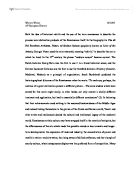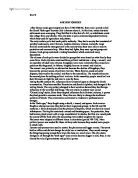The Age of Chivalry - Europe in the central middle ages - How successful were attempts to reform the Church in the period 1000-1250.
The Age of Chivalry: Europe in the central middle ages Peter Lawn
How successful were attempts to reform the Church in the period 1000-1250
The underlying aim of Church reform in the period 1000-1250 at least in terms of its rhetoric was to return the Catholic Church to the princilpes and practices of early Christianity. In practice this meant incresing the level of religious discipline and elimanating the abuses that existed in the Church itself. The reform of the Church in this period has two distinct phases. First of these was what have been called the “Gregorian reforms” of the eleventh century. They were centred principly on the papacy and the higher ecalons of the Church. The main aim of these reforms was to free the Church from lay control and put an end to the practice of Simony and Nichantilism. These aims were linked together in a number of ways. Simony was the practice of gainining ecclesiastical office in return for payment or service. This was seen as being the inevitably result of lay control of the church, specifically lay investiture. Removing lay contol of the Church was also important in making other reforms possible. Only a strong and independent Papacy would be capable of imposing changes across the Church in the middle ages. Without it reforms such as the eradication of Nichantilism by enforcing celibacy amoung the clergy would have been impossible. Freeing the Church from lay control was also seen as a laudable goal for its own sake removing the taint of the secular from the Church. The second phase of Church reform in theis period occurred later and was more to do with the monastic elements of the Church. The twelth century saw a spiritual revival in Europe. This was reflected in the rise of new monastic orders. It was nessecceary for the Church to reform to meet the needs of the time. The basis of this spiritual reawakening was the search for the “viva apostolica”. This meant returning to the principles and practices of the early Christianity to a greater extent than earlier reforms. The “viva apostolica” meant following more closely the example of the apostals, especially in terms of communal living and voluntary poverty. In what follows I will examine the extent to which the reforms began in the eleventh century were successul in achieving its aims of freeing the Church from lay conrol and ending the practice of Simony and Nichantilism. I will then look at the later monastic reforms and determine to what extent the Church and religious orders such as the cisteresians were succesful in bringing about change.
Attempts to reform the Church in the period 1000-1250 of any great significance were not made until Leo XI became Pope. Although the reforms that were brought in early in this period are often reffered to as Gregarion reforms after Pope Gregory VII it was Leo XI who set the process in motion. It was Leo XII who put the papacy at the head of the reform movement. He went on tours across Europe holding concils that were very successful in mobilising suppoert for reform. They allowed Church law to be set down in greater detail through the issueing of decrees and made the papacy the international institution it needed to be if its leadership of the Church was going to more than theoretical. In order for the reform of the Church to be succesful first there needed to be a “reformed and fortified papacy”. Only a strong independent papacy could impose and implement reforms on the rest of the Church. The reform of the papacy was then at the root of all other reform. Pope Urban II was the first to have any success freeing the papacy from lay control. He attempted to end the right of lay rulers to carry out the investiture of prelates. Compromises were reached with the rulers of England and France to the effect that they would continue to bestow prelates with their secular offices and the Church woul bestow spiritual offices by elecion in the presence of the ruler or his representative. Later after the concordant of Worms the same practice was brought in to the Holy Roman Empire. This reform was not only successful in making the investiture of prelates more religiously sound it also helped improve the position of the papacy. When Gregory VII became Pope he improved the position of the papacy further. Gregory VII was at “the centre of a vast movement of ideas”. He claimed the right to supreme control and supervision of the Church and secular rulers. He defined this suremacy as giving him the sole right to create Church laws and making him the ultimate arbitrator of their interpreation. It would also give hime the right to appoint and remove prelates or even secular rulers. In addition to this he claimed that only those who followed Rome were Catholics. In 1059 he initiated the reform of papal elections. This led to elections taking place outside Rome, where they had been heavily influenced by the Roman nobility. The Cardinals of Rome became much more important, gaining the right to propose the candidates and eventually becoming exclusivly responsible for electing Popes. This removed the influence of lay rulers over the Popes making them more independent. In this practice this reform was not initally successful but was eventually implemented. The Cardinals developed into a kind of court for the Pope, acting as his most imortant legates. This role allowed them to help consolidate Papal power and expand its reach. Acting as the Popes representative they could investigate abuses and hold councils. These local councils would spread legislation passed at papal councils. This helped to creat the standardised centralised hierachy that was esential to the implementation of successful reform. Another aspect of reform which was important in in standardising Church practices was the compiling of cannon law collections. These were large, comprehensive and widely read. This made them succsesseful in raising awareness of the right way of doing things. Papal reform was to a great extent successful. The pope had at least in theory achieved universal suprmacy. In practice this was not the case everywhere. In Easter Europe and Scandanavia the Pope’s influence continued to be weak, disputes over the investiture of Prelates had permenently soured relations between the Papaacy and the Holy Roman Empire, and reforms had also made the Pope less secure in Rome. Although secular rulers were now effectivly dependent on the papacy for their sacred titles there were limits to the Pope’s inflence, no King joined a crusade. However it can still be said that the power and preastige of the papacy increased dramatically as a result of reform in this period.







